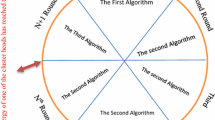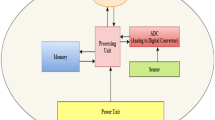Abstract
Besides sensing, computation, and communication of sensed data, the nodes near the base station have an additional responsibility to forward the data from far away nodes, leading to higher energy consumption around the base station. A solution to this bottleneck is to provide additional energy to such nodes, forming heterogeneous networks. Further stochastic cluster head selection leads to asymmetric energy dissipation among the nodes. This paper presents a fuzzy inspired energy-efficient protocol for a heterogeneous wireless sensor network with three types of nodes to compute feasibility of nodes to be assigned as cluster heads based on the residual energy of the node, its proximity to the base station, concentration and centrality. Most feasible nodes are assigned as cluster heads, followed by clustering and data transmission. The paper also mathematically derives optimal heterogeneity parameters to identify the number of nodes of a particular type along with the amount of energy to a particular node type. Further, the tradeoff between network timeline and percentage area covered too has been analyzed. The current work has been compared with recent protocols and the simulation outcomes show that FIEPE fairly justifies the network timeline requirement along with maximum percentage area coverage.










Similar content being viewed by others
References
Heinzelman, W. R., Chandrakasan, A., & Balakrishnan, H. (2000). Energy efficient communication protocol for wireless microsensor networks. In IEEE, proceedings of the Hawaii international conference on system sciences, January 4–7, Maui, Hawaii.
Heinzelman, W. B., Chandrakasan, A., & Balakrishnan, H. (2002). An application specific protocol architecture for wireless microsensor networks. IEEE Transactions on Wireless Communications,1(4), 660–670.
Bandyopadhyay, S., & Coyle, E. J. (2003). An energy efficient hierarchical clustering algorithm for wireless sensor networks. In IEEE INFOCOM 2003, 0-7803-7753-2/03.
Ying, L., & Haibin, Y.(2005). Energy adaptive cluster head selection for wireless sensor networks. In Proceeding of the sixth international conference on parallel and distributed computing, applications and technologies (PDCAT’05). IEEE Computer Society.
Comeau, F., Sivakumar, S. C., Robertson, W., & Phillips, W. J. (2006). Energy conserving architectures and algorithms for wireless sensor networks. In Proceedings of the 39th Hawaii international conference on system sciences, IEEE.
Tao, Y., & Zheng, Y. (2006). The combination of the optimal number of cluster heads and energy adaptive cluster head selection algorithm in wireless sensor networks. Wireless communications, networking and mobile computing. WiCOM, IEEE, ISSN-1-4244-0517-3. https://doi.org/10.1109/wicom.2006.289.
Tripathi, R. K., Singh, Y. N., & Verma, N. K. (2012). N-leach, a balanced cost cluster-heads selection algorithm for wireless sensor network. In National conference on communications (NCC). IEEE, https://doi.org/10.1109/ncc.2012.6176825.
Gupta, I., Riordan, D., & Sampalli, S. (2005). Cluster head election using fuzzy logic for wireless sensor networks. In Proceedings. 3rd annual communication networks and services research conference (pp. 255–260). May 2005.
Kim, J. M., Park, S. H., Han, Y. J., & Chung, T. M. (2008) CHEF: Cluster head election mechanism using fuzzy logic in wireless sensor networks. In Proceedings of 10th ICACT (pp.654–659) Feb. 2008.
Sharma, T., & Kumar, B. (2012). F-MCHEL: Fuzzy based master cluster head election leach protocol in wireless sensor network. International Journal of Computer Science and Telecommunications,3(10), 8–13.
Nayak, P., & Devulapalli, A. (2016). A fuzzy logic based clustering algorithm for WSN to extend the network lifetime. IEEE Sensors Journal,16(1), 137–144.
Nayak, P., Anurag, D., & Bhargavi, V. V. N. A. (2013). Fuzzy method based super cluster head election for wireless sensor network with mobile base station (FM-SCHM). In Proceedings. of the 2nd International. conference. advanced. computational. methodology (pp. 422–427).
Qing, Li, Zhu, Qingxin, & Wang, Mingwen. (2006). Design of a distributed energy efficient clustering algorithm for heterogeneous wireless sensor networks. Elsevier, Computer communications,29, 2230–2237. https://doi.org/10.1016/j.comcom.2006.02.017.
Halgamuge, M. N. (2006) Performance evaluation and enhancement of mobile and sensor networks. PhD Dissertation, University of Melbourne, Australia.
Zhang, H., & Hou, J. C. (2005). Maintaining sensing coverage and connectivity in large sensor networks. Adhoc and Sensor Wireless Networks, 1 (pp. 89–124) © 2005, Old City Publishing, Inc., https://doi.org/10.1201/9780203323687.
Smaragdakis, G., Matta, I., & Bestavros, A. (2004).SEP: A stable election protocol for clustered heterogeneous wireless sensor networks. BUCS technical reports; BUCS_TR_2004-022.
Author information
Authors and Affiliations
Corresponding author
Additional information
Publisher's Note
Springer Nature remains neutral with regard to jurisdictional claims in published maps and institutional affiliations.
Rights and permissions
About this article
Cite this article
Nehra, V., Sharma, A.K. & Tripathi, R.K. FIEPE: Fuzzy Inspired Energy Efficient Protocol for Heterogeneous Wireless Sensor Network. Wireless Pers Commun 110, 1769–1794 (2020). https://doi.org/10.1007/s11277-019-06811-2
Published:
Issue Date:
DOI: https://doi.org/10.1007/s11277-019-06811-2




